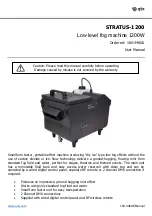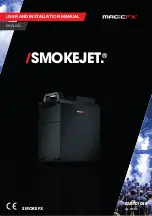
MAINTENANCE
A. MACHINE & ENGINE MAINTENANCE
1.
Refer to engine manufacturer’s owners manual and
comply completely with the instructions. Change
the oil and filter according to the Engine Owners
Manual. Recommended oil is SAE 10W-30.
2.
Keep a good service log on the machine with the
date, hour meter reading, type(s) of service per-
formed and the name of the person who performed
them.
3.
Clean the entire unit after each use. When cleaning
the unit, check for possible loose nuts and bolts.
B.
ENGINE MAINTENANCE METER
This multi-function meter acts as a preventive mainte-
nance tool; which benefits you with increased fuel
economy, less down time and longer engine life.
The meter’s displays are:
HOUR METER:
Displays total run hours when machine
is off.
TACHOMETER:
Indicates engine R.P.M. during op-
eration.
SERVICE ALERT:
The display flashes to alert you to
lube and change the oil at 25 hour intervals. The service
alert only flashes during operation and it warns you to
change the oil for only two hours. After the two hours
is reached, the alert will automatically reset to the next
25 hour interval. Therefore, it is recommended that a
separate maintenance log be kept to track oil changes.
REMEMBER THAT BEING SAFE IS A FULL-TIME,
EVERY DAY JOB. FOLLOW ALL INFORMATION
POSTED ON THE MACHINE AND THE LP TANK.
NEVER ALLOW ANYONE TO OPERATE THIS MA-
CHINE THAT HAS NOT READ OR CANNOT UNDER-
STAND THE GIVEN INSTRUCTIONS.
C.
TROUBLESHOOTING THE ELECTRICAL SYSTEM
1.
Check all wire connections for obvious problems.
Remove LPG tank, then remove battery box cover.
Check all connections visibly and physically. If
any “loose”, damaged or unconnected wires are
noticed, replace or repair as needed.
6
2.
Check the battery posts and wires.
Always wear a
face shield, safety glasses and protective clothing
when working around a battery!
The gases can be
explosive and the acid is highly corrosive to met-
als, cloth and ALL HUMAN TISSUE (skin, eyes,
etc.) If the battery post(s) are corroded, remove the
wires and clean posts and wires. Applying some
axle grease on the posts or the battery after they
are cleaned will slow down the battery corrosion
process.
If nothing obvious is noted, a more detailed investiga-
tion is warranted. Before any such troubleshooting be-
gins, the following things should be done:
3.
Replace propane (LPG) tank with one from a ma-
chine that runs.
4.
Charge the battery or provide an absolute source
of 12 volt DC power capable of 50 amperes total
output. (A pair of good jumper cables from your
car or truck battery will suffice.) Equip yourself
with an inexpensive 12 volt test light.
5.
If the trouble seems to be in the electrical control
equipment, you may wish to disconnect the starter
from the system so as to check the system without
spinning the engine.
D.
BELT, PAD DRIVE FACING, IDLER PULLEY OR
DRIVE SHAFT REPLACEMENT
1.
Tilt the machine back and adjust the handle forward
to enable the machine to stand on its’ rear wheels for
maintenance. A second person should aid in the lift
and secure the machine while being serviced.
2.
Remove the pad drive nut, pad centering device
and four bolts (9/16” wrench).
3.
Remove pad driver (replace if worn).
4.
Remove idler pulley (replace if worn).
5.
Remove belt(s). Replace if worn.
6.
To remove driveshaft unit: Remove retaining bolt
and clip, then pull driveshaft out of housing (a slide
hammer may assist in removal, do NOT pry with
crow bar). While drive shaft is removed spin bear-
ings. If roughness is felt, bearing replacement may
be necessary.
7.
Reassemble, follow above steps in reverse order.
Summary of Contents for TIGERRAY 21
Page 8: ...TigerRay 21 8...
Page 10: ...TigerRay 24 10...
Page 12: ...TigerRay 27 12...
Page 14: ...14 MAINTENANCE LOG...
Page 15: ...15 MAINTENANCE LOG...


































